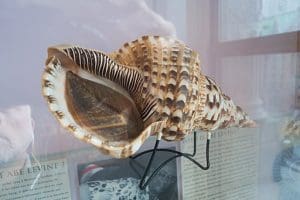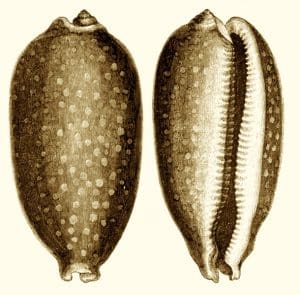
Searching for seashells is a vacation favorite for people of all ages, and it’s even more fun if you can identify the many colorful and unique shells you’ll find. This guide will show you some of the many kinds of seashells you may encounter, the best times and places to look for them, and some of the other things you might find on a beach while you’re searching. Central Rappahannock Regional Library also has seashell guides, opens a new window to help you identify what you discover.
The Best Times and Places for Searching
Typically, the best time to look is at low tide, opens a new window. Coastal areas usually experience two high tides and two low tides within every lunar day, opens a new window, which lasts 24 hours and 50 minutes. You can use NOAA’s online Tides and Currents, opens a new window guide to determine the high and low tides in your area. Also, hunting seashells after a storm may yield a greater bounty. As shown in this video, the variety of shells seen on the beach after a major storm is much greater.
You should be careful to pick a beach which will offer you a good shelling experience. You can travel to some of them on the East Coast without needing a plane ticket. Ocracoke, opens a new window is located at the very end of the Outer Banks in North Carolina and has many well-preserved beaches and good opportunities for seashell searching. In Maryland, you can visit Calvert Cliffs State Park,, opens a new window which offers many kinds of shells—and fossils as well. Further away, Sanibel Island, opens a new window in the south of Florida is considered one of the best beaches in the United States for shelling.
Beaches and Shell Varieties

The types of shells you’ll find depends on your beach’s location. On Ocracoke, you can find a good variety of shells, including both bivalves, opens a new window (mollusks with two shells) and gastropods, opens a new window (mollusks that have one large shell). Consider yourself very lucky if you find a helmet shell, opens a new window, which is a large, dome-shaped shell that may come in a variety of colors. The pink queen helmet is especially striking. Smaller but easier to find are the coquina clams, opens a new window. These bivalves are thin, and their shells can sometimes be fragile, but they come in a rainbow of colors and can be wonderful souvenirs of a beach visit. Olive shells, opens a new window, which are thin snail shells that have many intricate patterns on them, are another beloved souvenir of the Outer Banks.
Sanibel Island features its own distinctive set of seashells. If you are very lucky, you may find a large cowrie, opens a new window, which is a large, egg-shaped snail shell. More commonly, you might find a Florida fighting conch, opens a new window shell. This shell can easily be identified by its jagged, conical spire on one end. Of the bivalves at Sanibel, the most striking is the lion’s paw scallop, opens a new window. This large scallop shell ranges in color from dark red to orange, and, although the scallops are still common, finding a shell in good condition on the beach can be difficult. The luckiest explorers may find a junonia shell. This spotted snail shell is considered the jackpot of Sanibel shells, and if you find one, you may get your picture in the local newspaper!
The only beach on our list in the Potomac River area, Calvert Cliffs has a unique selection of shells. You may find the fossilized shells of Chesapecten jeffersonius, opens a new window, an extinct scallop that lived 4-5 million years ago. You can find other fossils, opens a new window here, including fossilized shark’s teeth. If you are especially lucky, you may find a Megalodon, opens a new window tooth here! You may also find varieties of gastropod fossils, including moon snails and limpets. Oyster shells from the Potomac River are often found here, too.
Other Beach Creatures
You may find other creatures on the beach as well. Make sure to check any gastropod shell you find to make sure it’s empty, because some of them may have hermit crabs, opens a new window inside. The hermit crabs found along the seashore still require access to the sea’s salty water in order to breathe and reproduce and should not be taken from the beach. Depending on which beach you visit, taking a live hermit crab may actually be illegal. Hermit crabs differ from other types of crustaceans because they must continually find and replace the “home” on their back, which will usually be a seashell. Be sure to leave a few seashells on the beach after your search so the growing hermit crabs can find a new shell for protection. Also, check your shells’ interiors for decaying matter that must be cleaned out before they are stored or transported.

You may also find sand dollars, opens a new window. Sand dollars are not a shell, but actually a flat type of sea urchin. A living, opens a new window sand dollar looks quite different than those you should search for; the body is covered in tiny spines and is colored reddish-brown to purple. What you’ll be looking for on the beach is actually the exoskeleton, opens a new window of a dead sand dollar, which will always be a bleached white color and will not have any spines remaining. It will have a radial imprint in the center that resembles the stylized petals of a flower. Finding a sand dollar in good shape can be quite challenging, as they are thin and fragile. Move your sand dollar very carefully to prevent damage!
Another thing to look for on the beach is a mermaid’s purse, opens a new window. Mermaid’s purses are the egg cases of sharks and rays, cast off and washed up on the beach after the babies have hatched. The best way to find mermaid’s purses is to look in the seaweed at the high tide line, opens a new window. Mermaid’s purses are typically attached to seaweed by the sharks and rays that produce them, and, when they wash up, they are often found in clumps of seaweed. A typical mermaid’s purse is shaped like a pouch, opens a new window, with two curled wiry “horns” on both ends. It can be difficult to identify the type of shark that laid the purse, as they often lose their shape and turn dark brown or black from exposure to the sun. You may be able to identify it better by bringing it home, putting it in a jar or bowl of seawater for a few hours, and then looking up a picture of the egg case online. Rehydrating, opens a new window the purse will be a big help in understanding what shark it came from.
Hunting for Shells at the Library
Before your beach trip, be sure to use CRRL’s resources to help you in your shell search. Take a look at some of our books, opens a new window on seashells and beaches to help you in your search. You may be surprised by the rarity and beauty of what you find.
Books on seashells and how to find them on beaches

